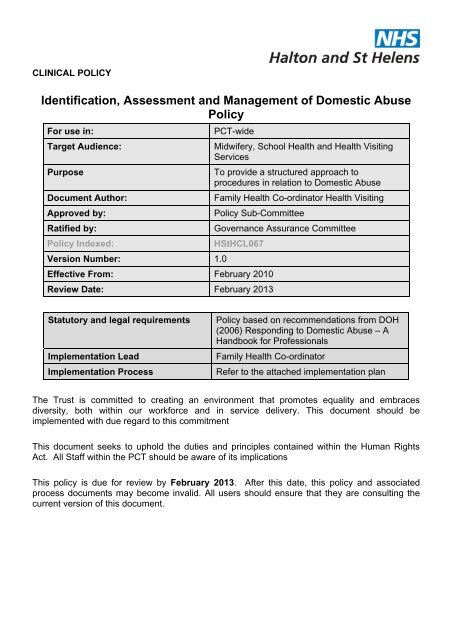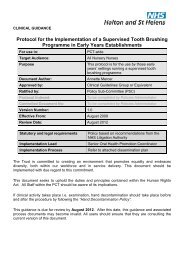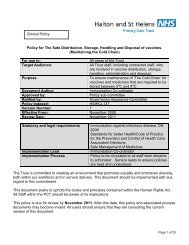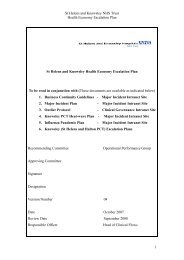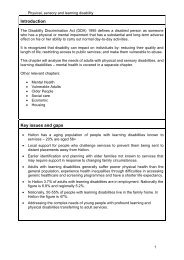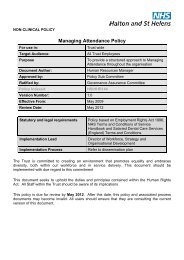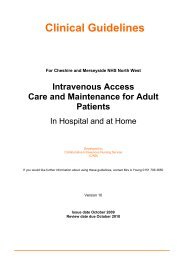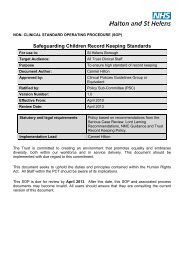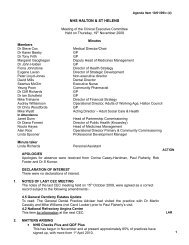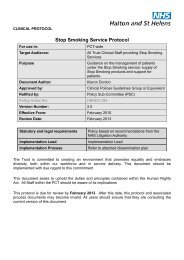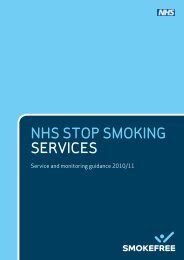Identification Assessment and Management of Domestic Abuse Policy
Identification Assessment and Management of Domestic Abuse Policy
Identification Assessment and Management of Domestic Abuse Policy
You also want an ePaper? Increase the reach of your titles
YUMPU automatically turns print PDFs into web optimized ePapers that Google loves.
CLINICAL POLICY<br />
<strong>Identification</strong>, <strong>Assessment</strong> <strong>and</strong> <strong>Management</strong> <strong>of</strong> <strong>Domestic</strong> <strong>Abuse</strong><br />
<strong>Policy</strong><br />
For use in:<br />
PCT-wide<br />
Target Audience:<br />
Midwifery, School Health <strong>and</strong> Health Visiting<br />
Services<br />
Purpose<br />
To provide a structured approach to<br />
procedures in relation to <strong>Domestic</strong> <strong>Abuse</strong><br />
Document Author:<br />
Family Health Co-ordinator Health Visiting<br />
Approved by:<br />
<strong>Policy</strong> Sub-Committee<br />
Ratified by:<br />
Governance Assurance Committee<br />
<strong>Policy</strong> Indexed:<br />
HStHCL067<br />
Version Number: 1.0<br />
Effective From: February 2010<br />
Review Date: February 2013<br />
Statutory <strong>and</strong> legal requirements<br />
Implementation Lead<br />
Implementation Process<br />
<strong>Policy</strong> based on recommendations from DOH<br />
(2006) Responding to <strong>Domestic</strong> <strong>Abuse</strong> – A<br />
H<strong>and</strong>book for Pr<strong>of</strong>essionals<br />
Family Health Co-ordinator<br />
Refer to the attached implementation plan<br />
The Trust is committed to creating an environment that promotes equality <strong>and</strong> embraces<br />
diversity, both within our workforce <strong>and</strong> in service delivery. This document should be<br />
implemented with due regard to this commitment<br />
This document seeks to uphold the duties <strong>and</strong> principles contained within the Human Rights<br />
Act. All Staff within the PCT should be aware <strong>of</strong> its implications<br />
This policy is due for review by February 2013. After this date, this policy <strong>and</strong> associated<br />
process documents may become invalid. All users should ensure that they are consulting the<br />
current version <strong>of</strong> this document.
Key individuals involved in developing the document<br />
Name<br />
Designation<br />
Carol Hornby<br />
Libby Evans<br />
Pauline Pinder<br />
Carmel Hilton<br />
Sue Bennett<br />
Madeleine Ashcr<strong>of</strong>t<br />
Family Health Co-ordinator – Health Visiting.<br />
Halton<br />
Health Co-ordinator School Health – Halton<br />
<strong>Domestic</strong> <strong>Abuse</strong> Midwife- Halton<br />
Named Nurse Child Protection- St Helens<br />
Family Health Co-ordinator- Halton<br />
Family Health Co-ordinator- Halton<br />
Distributed to the following for comments <strong>and</strong> approval<br />
Committee<br />
Members <strong>of</strong> the <strong>Policy</strong> Sub Committee<br />
Members <strong>of</strong> the Clinical Guidelines Group<br />
Cheshire Police<br />
Survivor Group – Women’s Aid<br />
Individual<br />
Designation<br />
Karen Worthington<br />
Peter Connaulty<br />
Charlie Whelan<br />
Sally Clarke<br />
Lucy Phillips<br />
Hayley Sanson<br />
Linda Spooner<br />
Lorna Hutcheon<br />
Women’s Aid Forum<br />
Margaret Evans<br />
Corina Casey-Hardman<br />
Pat Byrne<br />
Julie Banat<br />
Lesley Brownlow<br />
Preschool Children’s Manager-Halton<br />
Information Governance<br />
Senior Nurse Child Protection-Halton<br />
Halton <strong>Domestic</strong> <strong>Abuse</strong> Coordinator-Halton<br />
Supervisor <strong>of</strong> Midwives<br />
Clinical Audit Manager<br />
Pr<strong>of</strong>essional Development Manager<br />
Cheshire Police<br />
Halton<br />
Caldicott Guardian<br />
Head <strong>of</strong> Midwifery-Halton<br />
School Health Nursing Service Mger-Halton<br />
Health Visiting Manager-St Helens<br />
School Health Nursing Service Manager-St<br />
Helens<br />
Page 2 <strong>of</strong> 41
Table <strong>of</strong> Contents<br />
Introduction ..................................................................................................................................4<br />
Purpose........................................................................................................................................4<br />
Definition ......................................................................................................................................5<br />
Prevalence <strong>and</strong> Effects <strong>of</strong> <strong>Domestic</strong> <strong>Abuse</strong> .................................................................................5<br />
Indicators <strong>of</strong> <strong>Abuse</strong> ......................................................................................................................6<br />
The Effects <strong>of</strong> <strong>Domestic</strong> <strong>Abuse</strong>....................................................................................................7<br />
Multi-agency working ...................................................................................................................9<br />
Equal Opportunities ...................................................................................................................11<br />
References.................................................................................................................................22<br />
Associated Documentation ........................................................................................................25<br />
Appendix 1 .................................................................................................................................26<br />
Appendix 2 .................................................................................................................................27<br />
Appendix 3 .................................................................................................................................28<br />
Appendix 4 .................................................................................................................................29<br />
Appendix 5 .................................................................................................................................35<br />
Appendix 6 .................................................................................................................................40<br />
Appendix 7 .................................................................................................................................41<br />
Page 3 <strong>of</strong> 41
INTRODUCTION<br />
<strong>Domestic</strong> <strong>Abuse</strong> is a widespread, <strong>of</strong>ten hidden, problem. Its impact upon victims <strong>and</strong> their<br />
families is difficult to assess <strong>and</strong> remains a challenge for health pr<strong>of</strong>essionals. However, there<br />
are many clear messages from the government <strong>and</strong> research that indicates that pr<strong>of</strong>essionals<br />
should be proactive in their response to this significant public health issue.<br />
The child health <strong>and</strong> midwifery services provide a universal community based service to<br />
pregnant women, families <strong>and</strong> children that is, perceived as non stigmatising <strong>and</strong> accessible. It<br />
<strong>of</strong>fers:<br />
<br />
<br />
<br />
<br />
<br />
<br />
The delivery <strong>of</strong> a broad range <strong>of</strong> health improvement programmes based on a health<br />
needs assessment.<br />
The provision <strong>of</strong> support services to mothers in the antenatal <strong>and</strong> post natal period.<br />
The provision <strong>of</strong> preventative health care.<br />
Supporting vulnerable children <strong>and</strong> families.<br />
Ensuring appropriate referrals to other agencies.<br />
The identification <strong>of</strong> potential risk to health.<br />
Given the unique form <strong>of</strong> access that the services have to clients <strong>and</strong> their families, they are in a<br />
strong position to identify <strong>and</strong> respond to domestic abuse.<br />
PURPOSE<br />
The purpose <strong>of</strong> this policy is to provide staff working in Midwifery, Health Visiting <strong>and</strong> School<br />
Health Services within Family <strong>and</strong> Children’s Services with information <strong>and</strong> guidance about the<br />
identification, assessment <strong>and</strong> management <strong>of</strong> domestic abuse <strong>and</strong> their responsibilities within<br />
it, following an identified pathway (Appendix 1). It is underpinned by 10 st<strong>and</strong>ards <strong>of</strong> good<br />
practice, documented below.<br />
Objectives<br />
The following policy will assist services in the identification, assessment <strong>and</strong> management <strong>of</strong><br />
domestic abuse. The policy focuses on women <strong>and</strong> children, given the higher prevalence <strong>of</strong><br />
male violence towards women but also as domestic abuse <strong>of</strong>ten begins or escalates during<br />
pregnancy or shortly after childbirth. It is recognised however that men also experience abuse<br />
<strong>and</strong> abuse occurs in same sex relationships, <strong>and</strong> this policy is applicable to all sexes <strong>and</strong> types<br />
<strong>of</strong> relationships.<br />
This policy will be supported by education <strong>and</strong> training which will enable the child health <strong>and</strong><br />
maternity service to support women, children <strong>and</strong> others with the issue <strong>of</strong> domestic abuse<br />
Page 4 <strong>of</strong> 41
The overall objectives <strong>of</strong> the child health <strong>and</strong> midwifery service are to:<br />
<br />
<br />
<br />
<br />
<br />
<br />
<br />
<br />
Place domestic abuse on the agenda, incorporating it as a normal part <strong>of</strong> health<br />
assessment<br />
Perform routine enquiries at key times e.g. antenatal booking, antenatal contacts,<br />
antenatal health needs assessment <strong>and</strong> within the first year <strong>of</strong> life<br />
Empower people to make informed choices about their lives<br />
Promote awareness <strong>of</strong> the nature <strong>and</strong> impact <strong>of</strong> domestic abuse<br />
Ensure information is available<br />
Refer to specialist agencies where appropriate<br />
Provide regular support to women’s refuge <strong>and</strong> their residents<br />
To work effectively within interagency partnerships<br />
DEFINITION<br />
“Any incident <strong>of</strong> threatening behaviour, violence or abuse (psychological, physical,<br />
sexual, financial or emotional) between adults, who are or have been intimate partners or<br />
family members, regardless <strong>of</strong> gender or sexuality”<br />
The Department <strong>of</strong> Health (2005) <strong>and</strong> the Home Office (2003) both use the following definition<br />
<strong>of</strong> <strong>Domestic</strong> <strong>Abuse</strong>.<br />
PREVALENCE AND EFFECTS OF DOMESTIC ABUSE<br />
<br />
<br />
<br />
Two women are killed every week by a current or former partner.<br />
20% <strong>of</strong> women state they have been physically assaulted by a partner at some point.<br />
30% <strong>of</strong> domestic violence occurs in pregnancy starts during pregnancy.<br />
35% <strong>of</strong> households that experience a first assault will experience a second within 5<br />
weeks.<br />
<br />
<br />
<br />
52% <strong>of</strong> child protection cases involve domestic violence.<br />
54% <strong>of</strong> rapes are committed by current or former partner.<br />
70% <strong>of</strong> children living in refuges have been abused by their father.<br />
75% <strong>of</strong> the cases <strong>of</strong> domestic violence result in physical injury or mental health<br />
consequences to women.<br />
<br />
<br />
90% <strong>of</strong> domestic violence happens when children are in the same or next room.<br />
The police in the UK receive a call to stop domestic violence every minute.<br />
These are reported cases. They will therefore be underestimates <strong>of</strong> the true figure.<br />
(Dept <strong>of</strong> Health 2005)<br />
Page 5 <strong>of</strong> 41
INDICATORS OF ABUSE<br />
Possible indicators <strong>of</strong> domestic abuse<br />
As follows:<br />
<br />
<br />
<br />
<br />
<br />
<br />
<br />
Suspicious injury<br />
Partner always present <strong>and</strong> answers for the woman or dem<strong>and</strong>s early discharge from<br />
medical care<br />
Evasive presentation<br />
Depression, alcohol <strong>and</strong> drug abuse<br />
Self neglect<br />
Regular non-attendance for appointments<br />
Babies presenting with indicators e.g. sleep problems, behavioural problems<br />
Victims may exhibit physical, emotional or behavioural symptoms<br />
Physical<br />
<br />
<br />
<br />
<br />
<br />
Unexplained burns or bruises, multiple injuries in various stages <strong>of</strong> healing, repeated<br />
<strong>of</strong> chronic injuries<br />
Injuries in areas <strong>of</strong> the body inconsistent with falls, walking into doors or other<br />
explanations given<br />
Injuries to the breast, chest, abdomen, face head or neck<br />
Evidence <strong>of</strong> sexual abuse or frequent gynaecological problems<br />
Frequent complaints <strong>of</strong> vague illness <strong>and</strong> symptoms<br />
Emotional<br />
Feelings <strong>of</strong> isolation<br />
Suicide attempts<br />
Panic attacks/anxiety/depression<br />
Alcohol or drug abuse<br />
Post traumatic stress reaction/disorder<br />
Behavioural<br />
Person may be frightened, evasive, ashamed or embarrassed<br />
Partner accompanies victim, intent on staying close <strong>and</strong> answers questions directed<br />
at her<br />
Reluctance <strong>of</strong> victim to speak or disagree<br />
Denial or minimisation by partner or victim<br />
Page 6 <strong>of</strong> 41
THE EFFECTS OF DOMESTIC ABUSE<br />
Effects on the Victim<br />
The consequences <strong>of</strong> domestic abuse on the victim can vary greatly with each individual <strong>and</strong><br />
may depend on frequency <strong>of</strong> the abuse suffered. It may include:<br />
The following is a list <strong>of</strong> possible effects <strong>of</strong> <strong>Domestic</strong> <strong>Abuse</strong>, although it is not a comprehensive<br />
or exhaustive list.<br />
Physical<br />
<br />
<br />
<br />
<br />
Physical ill health<br />
Tiredness <strong>and</strong> lack <strong>of</strong> energy or too much energy<br />
Children could be conceived as a result <strong>of</strong> rape<br />
Violence escalates in pregnancy<br />
Emotional<br />
Continual <strong>and</strong> persistent fear<br />
Feelings <strong>of</strong> worthlessness <strong>and</strong> inadequacy<br />
Lack <strong>of</strong> confidence<br />
An erosion <strong>of</strong> self-esteem<br />
Feeling undermined <strong>and</strong> blamed<br />
Not allowed to develop<br />
Inability to maintain meaningful relationships<br />
Isolation from family, friends <strong>and</strong> community<br />
Feeling there is no way out <strong>of</strong> the situation<br />
Behavioural<br />
Inability to think clearly<br />
Inability to settle <strong>and</strong> lack <strong>of</strong> sleep<br />
Reliance on alcohol <strong>and</strong>/or drugs as a coping mechanism<br />
Eating disorders/self harm/suicide<br />
Mental ill-health or the appearance <strong>of</strong> mental health symptoms<br />
Page 7 <strong>of</strong> 41
Complications in Pregnancy<br />
still birth,<br />
repeated miscarriage,<br />
bleeding, premature rupture <strong>of</strong> membranes,<br />
placental abruption,<br />
low birth weight,<br />
ruptured uterus, liver or spleen,<br />
recurrent urine infections,<br />
anxiety <strong>and</strong> depression<br />
RCOG (2004)<br />
Effects <strong>of</strong> <strong>Domestic</strong> <strong>Abuse</strong> on Children<br />
Children may become directly involved in domestic abuse through attempting to protect their<br />
mother or through being encouraged or forced to participate in the abuse <strong>and</strong> humiliation <strong>of</strong><br />
their mother.<br />
Children’s responses vary enormously with some children being affected far more than others<br />
<strong>and</strong> children within the same family can be affected differently. Each child’s experience <strong>and</strong><br />
reaction will be unique. It will be hard to discern the impact if living with domestic violence on<br />
children, especially as some resulting behaviours also occur in children experiencing other<br />
forms <strong>of</strong> abuse <strong>and</strong> neglect (Hester et al 2004) However a report recently issued by the United<br />
Nations on the impact <strong>of</strong> aggressive behaviour in the home, states that nearly 1 million children<br />
in Britain may be suffering the physical <strong>and</strong> emotional scars <strong>of</strong> domestic violence.<br />
The effects <strong>of</strong> domestic abuse on children tend to vary according to;<br />
<br />
<br />
<br />
<br />
<br />
<br />
Age<br />
The level <strong>of</strong> violence<br />
The length <strong>of</strong> time the abuse has been happening<br />
Whether they are directly involved<br />
The extent to which they have witnessed the violence<br />
How much support they get from other people<br />
Refer to the leaflet on <strong>Domestic</strong> Violence the Effects on Children for more specific effects on<br />
children. <br />
Or enter the following into your address bar to search for the form on the intranet.<br />
http://sharepointcompliance/Appendices/Forms/AllItems.aspxb<br />
Page 8 <strong>of</strong> 41
The Effects <strong>of</strong> <strong>Domestic</strong> <strong>Abuse</strong> on Parenting<br />
Experiencing <strong>Domestic</strong> <strong>Abuse</strong> can affect the parent’s ability to parent. Some victims can<br />
achieve a consistent level <strong>of</strong> parenting, however, for others the reaction <strong>of</strong> altering states <strong>of</strong><br />
hyper arousal <strong>and</strong> numbing associated with trauma can serve to diminish their ability to parent<br />
effectively. (Calder 2004)<br />
Victims, (usually the mother) may have difficulty controlling their emotions <strong>and</strong> it should be<br />
remembered how this could affect their children.<br />
<br />
<br />
<br />
<br />
Violent, irrational or withdrawn behaviour frightens children<br />
Highly critical parenting can lead to insecure attachment<br />
Exposure to <strong>Domestic</strong> <strong>Abuse</strong> can lead to the victim suffering from depression,<br />
increased isolation <strong>and</strong> the abuse <strong>of</strong> alcohol/drugs may be used as a coping<br />
mechanism. This can result in ineffective <strong>and</strong> inconsistent parenting<br />
The abuser generates high levels <strong>of</strong> arousal <strong>and</strong> fear within the household. This<br />
impacts negatively on both the victim <strong>and</strong> the children’s self esteem <strong>and</strong> erodes their<br />
confidence.<br />
(Cleaver et al 1999, Hester et al 2000)<br />
Women (<strong>and</strong> her children) become more vulnerable when:<br />
<br />
<br />
<br />
<br />
<br />
They enter relationships when they are young<br />
They become pregnant<br />
They try to leave the relationship<br />
They fail to recognise the warning signs in their partners personality <strong>and</strong> behaviour<br />
Once separated, during contact visits with the children<br />
The Interconnection between <strong>Domestic</strong> <strong>Abuse</strong> <strong>and</strong> Child <strong>Abuse</strong><br />
Documents such as “<strong>Domestic</strong> Violence <strong>and</strong> social care” (1995), “Messages from the Research”<br />
(DOH 1995) <strong>and</strong> “Working together to safeguard children” (2006) all indicate that domestic<br />
abuse <strong>and</strong> child abuse are significantly intertwined.<br />
MULTI-AGENCY WORKING<br />
Sharing <strong>of</strong> information in cases <strong>of</strong> concern about children’s welfare will enable pr<strong>of</strong>essionals to<br />
consider jointly how to act in the best interests <strong>of</strong> the child. The key principles that guide<br />
decision making on information sharing are<br />
<br />
Pr<strong>of</strong>essionals must explain to children <strong>and</strong> their families at the outset what information<br />
could be shared with other pr<strong>of</strong>essionals, <strong>and</strong> why. Their agreement should be<br />
sought, except:<br />
Page 9 <strong>of</strong> 41
o Where to do so would put the child or any other person at risk <strong>of</strong> harm<br />
o If it would undermine the prevention, detection or prosecution <strong>of</strong> a serious<br />
crime<br />
The safety <strong>and</strong> welfare <strong>of</strong> the child must be the overriding consideration when<br />
pr<strong>of</strong>essionals are deciding whether to share information<br />
Pr<strong>of</strong>essionals should, wherever possible, respect the wishes <strong>of</strong> children <strong>and</strong> families,<br />
who do not consent to information being shared, but may still share that information if,<br />
from a judgement on the facts <strong>of</strong> the case, they feel there is sufficient need.<br />
Pr<strong>of</strong>essionals must seek advice from their line manager if they are in doubt<br />
Any information shared must be accurate <strong>and</strong> up to date, necessary for the purpose<br />
for which it is being shared, shared only with those who have a need to know, <strong>and</strong><br />
shared in a secure way<br />
Pr<strong>of</strong>essionals must always record the reasons for their decision, whether it is to share<br />
information or not.<br />
If a child / children are deemed to be at risk <strong>of</strong> significant harm, a referral should be<br />
made to Children’s Social Care under local safeguarding procedures.<br />
Halton Safeguarding Board (2007)<br />
Multi-Agency Risk <strong>Assessment</strong> Conferences (MARAC)<br />
MARACs are aimed primarily at protecting very-high risk victims <strong>of</strong> domestic abuse from serious<br />
injury/homicide.<br />
The aim <strong>of</strong> a MARAC is to:<br />
Share information to increase the safety, health <strong>and</strong> wellbeing <strong>of</strong> victims, other<br />
vulnerable adults <strong>and</strong> their children;<br />
Determine whether the perpetrator poses a significant risk to any particular individual<br />
or to the general community<br />
Jointly construct <strong>and</strong> implement a risk management plan that provides pr<strong>of</strong>essional<br />
support to all those at risk <strong>and</strong> that reduces the risk <strong>of</strong> harm;<br />
<br />
<br />
<br />
Reduce repeat victimisation;<br />
Improve agency accountability; <strong>and</strong><br />
Improve support for staff involved in high-risk cases.<br />
Page 10 <strong>of</strong> 41
Risk assessment is the main factor that underpins the MARAC. Risk assessment tools can<br />
provide a structured way to assess the relevant information. It should be clear that there is not<br />
an expectation <strong>of</strong> those completing the initial risk assessment to have high levels <strong>of</strong> knowledge<br />
about domestic abuse <strong>and</strong> its assessment. Halton <strong>Domestic</strong> <strong>Abuse</strong> Forum (2007).<br />
The Department <strong>of</strong> Health (2005) acknowledge that it is important to determine the extent <strong>of</strong> the<br />
danger faced by a woman <strong>and</strong> her children. The assessment <strong>and</strong> management <strong>of</strong> risk can<br />
never be an exact science, it involves working with uncertainty <strong>and</strong> undertaking continuing <strong>and</strong><br />
complex levels <strong>of</strong> analysis (CAFCASS 2005).In considering the risk, the responsibility as a<br />
health pr<strong>of</strong>essional is to support the woman in the decisions <strong>and</strong> choices she makes (SWLHP<br />
2005).<br />
The risks outlines in the Victim Risk Indicator (Refer to appendix 4) can be used by practitioners<br />
in identifying <strong>and</strong> assessing the behaviours that could indicate an escalation in violence or a<br />
continued risk to the children or parent even after separation. If a client is deemed to be at veryhigh<br />
risk <strong>of</strong> homicide or serious injury, a referral should be made to MARAC. (Refer to appendix<br />
5).<br />
The client’s immediate risks should be addressed by referral to appropriate local services such<br />
as the Police, Independent <strong>Domestic</strong> Violence Advocate, Women’s Aid, Accident Emergency<br />
Department. This policy should be read in conjunction with the relevant borough local agency<br />
procedures, protocols <strong>and</strong> supporting documentation.<br />
EQUAL OPPORTUNITIES<br />
Practitioners working with <strong>Domestic</strong> <strong>Abuse</strong> should be alert to the dangers <strong>of</strong> stereotyping on the<br />
grounds <strong>of</strong> race, gender, sexual orientation or ability. Do not attempt to justify <strong>Domestic</strong> <strong>Abuse</strong><br />
on cultural grounds <strong>and</strong> be aware that some societies are open to other forms <strong>of</strong> oppression,<br />
which may compound <strong>and</strong> complicate their situation. For example, belonging to an ethnic<br />
minority, having a disability, suffering from physical or mental illness, being an older or very<br />
young person, being in a same sex relationship, belonging to a travelling community, or being a<br />
drug or alcohol user.<br />
Page 11 <strong>of</strong> 41
STANDARD ONE – CONFIDENTIALITY<br />
St<strong>and</strong>ard Action Rationale<br />
Pr<strong>of</strong>essionals need to be<br />
aware <strong>of</strong> the need to<br />
maintain confidentiality<br />
<br />
All pr<strong>of</strong>essionals<br />
recognise the duty to<br />
respect the woman’s<br />
confidentiality but must<br />
be aware <strong>of</strong> its<br />
limitations when<br />
protection <strong>of</strong> the child or<br />
adult takes priority<br />
If the woman withholds<br />
consent, or if consent<br />
cannot be obtained, sharing<br />
<strong>of</strong> information may be made<br />
where:<br />
They are required by<br />
law or by order <strong>of</strong> a<br />
court<br />
Where there are<br />
potential child protection<br />
issues<br />
The pr<strong>of</strong>essional is<br />
justified <strong>and</strong> has a duty<br />
to share information with<br />
social services, the<br />
police or other agencies,<br />
where there is an<br />
increased risk to the<br />
woman/child protection<br />
concerns<br />
The law recognises significant<br />
exceptions to the duty <strong>of</strong><br />
confidentiality<br />
To act in accordance with national<br />
<strong>and</strong> local policies <strong>and</strong> guidance<br />
To protect the woman or child <strong>and</strong><br />
to follow PCT procedures<br />
KPI information shared with/without consent. Rationale documented when consent not given.<br />
Page 12 <strong>of</strong> 41
STANDARD TWO – ROUTINE ENQUIRY<br />
St<strong>and</strong>ard Action Rationale<br />
All women will be<br />
routinely asked about<br />
domestic abuse in the<br />
antenatal period <strong>and</strong><br />
within the first year <strong>of</strong> life<br />
Women should be alone<br />
when asked about<br />
domestic abuse<br />
Information to be given<br />
to women as a matter <strong>of</strong><br />
course<br />
Ensure lone contact<br />
with the woman at least<br />
once in pregnancy <strong>and</strong><br />
at least once in the first<br />
year <strong>of</strong> life<br />
If unable to see the<br />
woman alone, highlight<br />
this as a priority for<br />
follow up<br />
Routine enquiry should<br />
not be a one-<strong>of</strong>f. It<br />
should be opportunistic<br />
throughout the<br />
pregnancy <strong>and</strong> during<br />
contacts with the family<br />
particularly where there<br />
are possible indicators<br />
<strong>of</strong> abuse<br />
Ensure the provision <strong>of</strong><br />
a safe supportive<br />
environment<br />
Ensure effective<br />
communication takes<br />
place between<br />
midwife/health<br />
visitor/school health<br />
nurse<br />
If communication difficulties<br />
exist,<br />
Arrange pr<strong>of</strong>essional<br />
interpreter(not family<br />
member)<br />
Signer or advocate for<br />
learning difficulties<br />
To raise awareness <strong>of</strong> nature <strong>of</strong><br />
domestic abuse<br />
To provide opportunity for<br />
disclosure to take place<br />
KPI women routinely asked at booking or during pregnancy, ante-natal or within1 year following<br />
delivery<br />
Page 13 <strong>of</strong> 41
STANDARD THREE – DISCLOSURE<br />
St<strong>and</strong>ard Action Rationale<br />
Women who disclose will<br />
be given support <strong>and</strong><br />
information<br />
They will be <strong>of</strong>fered<br />
referrals to appropriate<br />
agencies<br />
<br />
<br />
<br />
<br />
Provide time for the<br />
woman<br />
Re-enforce that the<br />
abuse is not acceptable<br />
Respect the need for<br />
confidentiality<br />
Give accurate up to<br />
date information <strong>of</strong><br />
relevant agencies<br />
(Appendix 2)<br />
Give women opportunity to talk<br />
openly<br />
To ensure woman has an<br />
informed choice <strong>of</strong> action<br />
<br />
<br />
Ask the woman for<br />
consent to refer to other<br />
agencies or provide the<br />
woman with details on<br />
how to self refer<br />
Consider use <strong>of</strong> CAF<br />
To ensure child is protected.<br />
<br />
Offer the woman<br />
helpline numbers<br />
<br />
If you are concerned<br />
about the welfare <strong>of</strong> a<br />
child refer to Child<br />
protection<br />
nurse/midwife in<br />
accordance with local<br />
guidance<br />
KPI appropriate referrals/ actions taken, Consent obtained for information sharing, Liaison with<br />
safeguarding team where indicated.<br />
Page 14 <strong>of</strong> 41
STANDARD FOUR – DOCUMENTATION<br />
St<strong>and</strong>ard Action Rationale<br />
Keep detailed, accurate<br />
<strong>and</strong> clear records in<br />
relation to domestic<br />
abuse<br />
<br />
<br />
<br />
<br />
Ensure records are as<br />
detailed as possible<br />
Use the patient’s own<br />
words (in quotation<br />
marks) where possible<br />
Document injuries in as<br />
much detail <strong>and</strong> the<br />
clients explanation<br />
Document the full extent<br />
<strong>of</strong> abuse as known<br />
To ensure record keeping<br />
st<strong>and</strong>ards are met<br />
To comply with recording keeping<br />
policy<br />
To ensure records are<br />
comprehensive if required for legal<br />
purposes<br />
<br />
Provide a diagram <strong>of</strong><br />
injuries together with a<br />
written description <strong>of</strong><br />
any injuries (Appendix<br />
3)<br />
To facilitate multi-agency working.<br />
<br />
<strong>Domestic</strong> abuse should<br />
never be recorded in<br />
h<strong>and</strong> held notes<br />
<br />
Document whether<br />
children were present or<br />
witness at time <strong>of</strong> abuse<br />
<br />
Record your<br />
assessment <strong>and</strong> actions<br />
<br />
Sharing <strong>of</strong> information<br />
between pr<strong>of</strong>essionals<br />
should be recorded.<br />
Record keeping in relation to domestic abuse is detailed<br />
Page 15 <strong>of</strong> 41
STANDARD FIVE - RISK ASSESSMENT<br />
St<strong>and</strong>ard Action Rationale<br />
Assess risk to the<br />
woman, unborn baby or<br />
any other children in the<br />
house<br />
<br />
<br />
<br />
The practitioner should<br />
be aware <strong>of</strong> the DOH<br />
guidelines<br />
Assess level <strong>of</strong> risk to<br />
the client using clinical<br />
judgement.<br />
When assessment<br />
indicates client maybe<br />
at risk <strong>of</strong> serious<br />
physical injury/<br />
homicide or evidence <strong>of</strong><br />
current injuries<br />
complete the victim risk<br />
indicator. (Refer to<br />
appendix 4)<br />
To have an underst<strong>and</strong>ing <strong>of</strong><br />
domestic violence.<br />
To identify issues around<br />
domestic abuse.<br />
To identify the level <strong>of</strong> risk <strong>and</strong> to<br />
ensure appropriate referral.<br />
N.B. Very high risk should<br />
be referred to MARAC<br />
(Multi-Agency Risk<br />
<strong>Assessment</strong> Conference<br />
(via police) (Appendix 5)<br />
<strong>and</strong> a referral made to<br />
Children’s Social Care<br />
To maintain the safety <strong>of</strong> the client<br />
Immediate safety needs<br />
should be addressed.<br />
KPI Victim Risk indicator completed. Referrals to MARAC for very high risk score.<br />
Page 16 <strong>of</strong> 41
STANDARD SIX – CHILD PROTECTION<br />
St<strong>and</strong>ard Action Rationale<br />
Where actual or the<br />
likelihood <strong>of</strong> significant<br />
harm is identified, a<br />
referral under Child<br />
Protection Procedures<br />
must be made<br />
The welfare <strong>of</strong> any child<br />
is paramount, including<br />
the unborn child<br />
Consider also the<br />
implications for the<br />
pregnant teenager under<br />
19 yrs old<br />
Establish whether<br />
children are present in<br />
the home when abuse<br />
is taking place<br />
Assess impact on<br />
children <strong>and</strong> their<br />
health <strong>and</strong> wellbeing<br />
Consider other<br />
situations which may<br />
impact on the health<br />
<strong>and</strong> wellbeing <strong>of</strong> the<br />
child <strong>and</strong> take<br />
appropriate action<br />
Involve multi-agency<br />
partnerships, as<br />
appropriate<br />
Ask the woman for her<br />
consent for referral to<br />
other agencies<br />
Consider Common<br />
assessment framework<br />
Named Nurse/Midwife<br />
must be informed <strong>of</strong><br />
any concerns <strong>of</strong> a child<br />
protection nature.<br />
If you are unsure <strong>of</strong> the<br />
risk to unborn child,<br />
children seek guidance<br />
from/refer to Child<br />
Protection Nurse<br />
,/Midwife/ Specialist/<br />
Framework for<br />
<strong>Assessment</strong> <strong>of</strong><br />
Children in Need <strong>and</strong><br />
their families<br />
Consent is not essential<br />
where there are<br />
Child protection<br />
concerns/imminent threats<br />
to her safety.<br />
To ensure safety <strong>of</strong> child<br />
To ensure a holistic assessment <strong>of</strong><br />
child’s needs.<br />
To ensure best support for family.<br />
To provide targeted specialist<br />
services<br />
To ensure child’s needs are<br />
identified.<br />
To comply with local guidance<br />
To seek appropriate advice.<br />
KPI. Appropriate information sharing with consent. Appropriate information sharing with no<br />
consent <strong>and</strong> rationale. Referrals made to children’s social care for all clients with high risk score.<br />
Page 17 <strong>of</strong> 41
STANDARD SEVEN – SAFETY PLANNING FOR STAFF AND VICTIM<br />
St<strong>and</strong>ard Action Rationale<br />
Ensure women are<br />
equipped with accurate<br />
<strong>and</strong> appropriate advice<br />
to stay safe<br />
To ensure health<br />
pr<strong>of</strong>essionals are not<br />
placed in situations <strong>of</strong><br />
threat or danger<br />
Process <strong>of</strong> safety planning.<br />
Support the woman:<br />
Build a trusting, non<br />
judgemental<br />
relationship<br />
Encourage the woman<br />
to assess her safety<br />
needs<br />
Review current risk – to<br />
her own life <strong>and</strong> to her<br />
children/unborn child<br />
Be an advocate for the<br />
woman with other<br />
agencies(with consent)<br />
Undertake a risk<br />
assessment <strong>of</strong> your<br />
environment e.g. when<br />
visiting a woman in her<br />
own home<br />
Report incidents using<br />
incident reporting<br />
mechanisms. Liaise<br />
with other<br />
pr<strong>of</strong>essionals as<br />
appropriate<br />
To ensure woman has access to<br />
health pr<strong>of</strong>essionals.<br />
To ensure safety <strong>of</strong> woman.<br />
To ensure staff safety.<br />
NB Ensure that you do<br />
not place yourself or<br />
your colleague in a<br />
potential violent<br />
situation when<br />
supporting someone<br />
else<br />
Page 18 <strong>of</strong> 41
STANDARD EIGHT – PROVISION OF INFORMATION AND REFERRAL<br />
St<strong>and</strong>ard Action Rationale<br />
Provide woman with<br />
accurate information i.e.<br />
Resources, help <strong>and</strong><br />
Agencies available<br />
<br />
<br />
Adopt a calm, open<br />
approach<br />
All women will be<br />
<strong>of</strong>fered contact<br />
numbers <strong>of</strong> local<br />
support services<br />
To ensure woman can make an<br />
informed choice.<br />
To ensure best outcome for<br />
woman.<br />
Ensure multi-agency<br />
working<br />
<br />
Give information that is<br />
non judgemental <strong>and</strong><br />
accurate. Be courteous<br />
<strong>and</strong> empathic to her<br />
needs<br />
To ensure staff <strong>and</strong> public have<br />
access to information<br />
<br />
Provide written<br />
information should the<br />
woman want it.<br />
To aid communication.<br />
<br />
Display information on<br />
services available in<br />
the Trust<br />
<br />
<br />
Where possible<br />
engage the client with<br />
Specialist Services<br />
Address<br />
language/communicati<br />
on difficulties<br />
To prevent further episodes <strong>of</strong><br />
abuse.<br />
<br />
Provide information as<br />
to where the<br />
perpetrator can seek<br />
help as well as the<br />
woman<br />
KPI Contact numbers/ support information provided.<br />
Page 19 <strong>of</strong> 41
STANDARD NINE – SUPPORT AND SUPERVISION OF STAFF<br />
St<strong>and</strong>ard Action Rationale<br />
Adequate support should<br />
be provided to staff<br />
dealing with domestic<br />
abuse issues<br />
<br />
<br />
<br />
<br />
<br />
<br />
<br />
<br />
Safety <strong>and</strong> disclosure<br />
<strong>of</strong> information by<br />
support staff should be<br />
discussed with line<br />
manager<br />
Seek specialist advice<br />
from safeguarding<br />
team as appropriate<br />
Access to clinical<br />
supervision/midwifery<br />
supervision to be<br />
provided in order to<br />
allow staff to debrief,<br />
seek advice <strong>and</strong><br />
reflect.<br />
Explore own issues<br />
which may influence<br />
practice <strong>and</strong> seek<br />
advice accordingly<br />
Develop skills <strong>and</strong><br />
identify training needs<br />
Seek advice from<br />
specialist services if<br />
necessary<br />
Consider services <strong>of</strong><br />
occupational health<br />
Access <strong>and</strong> <strong>of</strong>fer<br />
support to colleagues<br />
KPI All staff dealing with <strong>Domestic</strong> <strong>Abuse</strong> access regular supervision.<br />
To ensure all staff dealing with<br />
domestic abuse access regular<br />
supervision.<br />
Specialist support is available to<br />
staff if required.<br />
Page 20 <strong>of</strong> 41
STANDARD TEN – EDUCATION AND TRAINING<br />
St<strong>and</strong>ard Action Rationale<br />
Staff will be <strong>of</strong>fered<br />
training to enable them to<br />
deal with issues involving<br />
domestic abuse.<br />
<br />
<br />
<br />
<br />
<br />
<br />
<br />
Staff should be aware<br />
<strong>of</strong> the prevalence <strong>and</strong><br />
indicators <strong>of</strong> abuse<br />
The effects <strong>of</strong> abuse<br />
on the victim <strong>and</strong><br />
children<br />
Types <strong>of</strong> abuse<br />
Staff should identify<br />
their own training<br />
needs<br />
Midwives <strong>and</strong> Health<br />
visitors should use<br />
routine enquiry as part<br />
<strong>of</strong> antenatal<br />
care/antenatal Health<br />
Needs <strong>Assessment</strong><br />
Ensure Health<br />
Pr<strong>of</strong>essional<br />
representation on local<br />
<strong>and</strong> strategic<br />
Safeguarding Boards<br />
<strong>and</strong> Operational/<br />
pr<strong>of</strong>essional forum.<br />
Induction <strong>of</strong> new staff<br />
to include awareness<br />
on issues relating to<br />
domestic abuse<br />
KPI All staff have attended awareness raising training<br />
To ensure staff have skills <strong>and</strong> tool<br />
required to identify <strong>and</strong> support<br />
clients suffering from domestic abuse<br />
Refer to the leaflet on <strong>Domestic</strong><br />
Violence the Effects on Children for<br />
more specific effects on children.<br />
<br />
Or enter the following into your<br />
address bar to search for the form<br />
on the intranet.<br />
http://sharepointcompliance/Appe<br />
ndices/Forms/AllItems.aspxb<br />
Page 21 <strong>of</strong> 41
REFERENCES<br />
Reference<br />
CAFCASS (2005)<br />
http://www.<strong>of</strong>sted.gov.uk/content/download/1765/11903/file/dome<br />
stic%20violence,%20safety<strong>and</strong>%20<strong>and</strong>%20family%20proceeding<br />
s%20(PDF%20format).pdf<br />
Relevance<br />
(whole<br />
document or<br />
section, please<br />
state)<br />
Evidence<br />
Grade<br />
Government<br />
Document<br />
Calder C.(2004)<br />
Children living with <strong>Domestic</strong> Violence, Lyme Regis: Russell<br />
House<br />
Cleaver H, Unell I, & Aldgate J (1999)<br />
Children’s Needs – Parenting capacity. The impact <strong>of</strong> mental<br />
illness, Problem Alcohol <strong>and</strong> Drug Misuse, <strong>and</strong> <strong>Domestic</strong><br />
Violence <strong>and</strong> Children’s Development. London HMSO<br />
DOH (1995)<br />
Child Protection. Messages from the research. London<br />
HMSO<br />
DOH (2005)<br />
Responding to domestic abuse: A h<strong>and</strong>book for<br />
Pr<strong>of</strong>essionals<br />
http://www.dh.gov.uk/en/Publications<strong>and</strong><br />
statistics/Publications<strong>Policy</strong>AndGuidance/DH_4126161<br />
<strong>Domestic</strong> Violence <strong>and</strong> Social Care (1995)<br />
<strong>Domestic</strong> Violence <strong>and</strong> Social Care (SSI 1995)<br />
Halton <strong>Domestic</strong> <strong>Abuse</strong> Forum (2007)<br />
Multi-Agency Risk <strong>Assessment</strong> Conference. Procedures,<br />
protocols <strong>and</strong> supporting documents<br />
Halton & St Helens (2007)<br />
<strong>Policy</strong> on Clinical Supervision<br />
Halton & St Helens (2004)<br />
E<br />
E<br />
E<br />
1<br />
E<br />
<strong>Policy</strong><br />
<strong>Policy</strong><br />
<strong>Policy</strong><br />
Page 22 <strong>of</strong> 41
Zero Tolerance <strong>and</strong> Lone Worker <strong>Policy</strong><br />
Halton Safeguarding Children Board(2007) Procedures to<br />
safeguard <strong>and</strong> promote the welfare <strong>of</strong> children<br />
Hester M, Pearson C, <strong>and</strong> Harwin N. (2000)<br />
Making an impact: children <strong>and</strong> <strong>Domestic</strong> Violence. London:<br />
Jessica Kingsley<br />
<strong>Policy</strong><br />
E<br />
1<br />
Home Office (2003)<br />
http://www.archive2.<strong>of</strong>ficialdocuments.co.uk/document/cm58/5847/5847.pdf<br />
RCOG(2004)<br />
Confidential Enquiry into Maternal Deaths – Why<br />
mothers<br />
die 2002-2002 RCOG Press, London, Engl<strong>and</strong><br />
St Helens Local Safeguarding Children Board (2006)<br />
Procedures to Safeguard children<br />
St Helens <strong>Domestic</strong> <strong>Abuse</strong> (Sep 2008)<br />
Sharing <strong>of</strong> information procedures<br />
SWLHP (2005)<br />
South Wales Local Healthcare Partnership<br />
A guide for Healthcare staff in Primary Care<br />
Working Together to Safeguard Children (2006)<br />
http://everychildmatters.gov.uk/resources_<strong>and</strong>-practice/IG00060/<br />
Zachary et al (2002). Multifaceted system <strong>of</strong> care to<br />
improve recognition <strong>and</strong> management <strong>of</strong> pregnant women<br />
experiencing domestic violence.<br />
NMC(2008) The code <strong>of</strong> st<strong>and</strong>ards for conduct,<br />
Performance <strong>and</strong> Ethics for Nurses <strong>and</strong> Midwives<br />
Whole<br />
NMC<br />
Guidance<br />
Halton Safeguarding Children Board(2007) Procedures to<br />
safeguard <strong>and</strong> promote the welfare <strong>of</strong> children<br />
Whole<br />
<strong>Policy</strong><br />
Page 23 <strong>of</strong> 41
St Helens Borough Council child protection Procedures<br />
Whole<br />
<strong>Policy</strong><br />
Home Office 2004 Safety <strong>and</strong> Justice: Sharing Personal<br />
Information in the context <strong>of</strong> <strong>Domestic</strong> Violence – an<br />
Overview.<br />
Home Office Development <strong>and</strong> Practice Report<br />
Communication, Development Unit. Home Office, London,<br />
Engl<strong>and</strong><br />
Whole<br />
Whole<br />
I<br />
I<br />
RCOG(2004) Confidential Enquiry into Maternal Deaths –<br />
Why mothers die 2002-2002 RCOG Press, London, Engl<strong>and</strong><br />
NICE (2008) Antenatal Care – Clinical guideline 62<br />
Section 5.3<br />
St<strong>and</strong>ard 2<br />
Enquiry<br />
DOH (2004) National Service Framework for Children<br />
St<strong>and</strong>ard 11 – Maternity Services<br />
Whole<br />
DOH2005) Responding to domestic abuse: A h<strong>and</strong>book for<br />
pr<strong>of</strong>essionals<br />
Zero Tolerance <strong>and</strong> Lone Worker <strong>Policy</strong> – Halton & St<br />
Helens (2004)<br />
Halton <strong>Domestic</strong> <strong>Abuse</strong> Forum Interagency Partnership<br />
Agreement 2007<br />
St Helens Local Partnership Agreement<br />
St<strong>and</strong>ard 7<br />
St<strong>and</strong>ard 5<br />
Whole<br />
Whole<br />
1<br />
<strong>Policy</strong><br />
<strong>Policy</strong><br />
Every Child Matters Dfes 2003 Framework for <strong>Assessment</strong><br />
<strong>of</strong> children in need <strong>and</strong> their families.<br />
Hughes H (1992) Impact <strong>of</strong> Spouse <strong>Abuse</strong> on Children <strong>of</strong><br />
Battered Women.<br />
Whole<br />
<strong>Policy</strong><br />
NCH Action for Children, London Engl<strong>and</strong>, Reynolds J<br />
(2001)<br />
Whole<br />
Not in Front <strong>of</strong> the Children, One Plus One, London,<br />
Engl<strong>and</strong><br />
1<br />
DOH (2003) What to do if you suspect a child is being<br />
<strong>Policy</strong><br />
Page 24 <strong>of</strong> 41
abused leaflet.<br />
Home Office (1999) <strong>Domestic</strong> Violence – breaking the chain.<br />
Multi agency guidance for addressing domestic violence.<br />
Whole<br />
Halton & St Helens <strong>Policy</strong> on Clinical<br />
Supervision/pr<strong>of</strong>essional support (2007)<br />
E<br />
NMC (2004) Midwives Rules <strong>and</strong> St<strong>and</strong>ards<br />
Zachary et al (2002). Multifaceted system <strong>of</strong> care to<br />
improve recognition <strong>and</strong> management <strong>of</strong> pregnant women<br />
experiencing domestic violence.<br />
ASSOCIATED DOCUMENTATION<br />
Halton Safeguarding Children Board (2007) Procedures to Safeguard <strong>and</strong> promote the<br />
welfare <strong>of</strong> Children<br />
St Helens Local Safeguarding Children’s Board.(2006) Safeguarding Procedures<br />
Halton & St Helens PCT. Clinical Supervision <strong>Policy</strong><br />
Halton & St Helens PCT. Zero Tolerance <strong>and</strong> Lone Worker <strong>Policy</strong><br />
Halton <strong>Domestic</strong> <strong>Abuse</strong> Forum. Multi-Agency Risk <strong>Assessment</strong> Conference (MARAC)<br />
Procedures, Protocols <strong>and</strong> Supporting Documents (Feb 2007)<br />
St Helens <strong>Domestic</strong> <strong>Abuse</strong>. Sharing <strong>of</strong> Information Procedures (Sep 2008)<br />
Page 25 <strong>of</strong> 41
APPENDIX 1<br />
Client disclosure at<br />
antenatal<br />
assessment or<br />
routine visit<br />
<strong>Domestic</strong> abuse assessment<br />
Assess risk to woman.<br />
Assess risk to child/ren/unborn<br />
child<br />
Assess clients needs<br />
St Helens<br />
Project (HV<br />
only)<br />
Third party contact<br />
(Police, marac, social<br />
services, health, other<br />
agency<br />
St<strong>and</strong>ard <strong>and</strong><br />
medium risk <strong>of</strong><br />
serious injury or<br />
homicide to client<br />
High risk <strong>of</strong> serious<br />
injury or homicide to<br />
client<br />
Very high risk <strong>of</strong><br />
serious injury or<br />
homicide to client<br />
Significant risk to<br />
children or unborn<br />
child<br />
Provide information<br />
Make appropriate referral.<br />
Obtain consent<br />
Liaise with other pr<strong>of</strong>essionals<br />
Consider CAF<br />
Seek guidance if unsure<br />
Liaise with safeguarding team<br />
as appropriate.<br />
A<br />
i i<br />
Refer to MARAC<br />
Discuss with<br />
Safeguarding team<br />
Refer to<br />
Children’s<br />
Social Care<br />
Discuss with<br />
safeguarding<br />
team<br />
Document<br />
<strong>and</strong> discuss<br />
at next<br />
appropriate<br />
contact<br />
Page 26 <strong>of</strong> 41
APPENDIX 2<br />
INFORMATION AND CONTACT DETAILS<br />
St Helens<br />
Child in Need Advisor/ Named Nurse 01744 627576<br />
Women’s Aid 01744 454438<br />
Family Support Unit 0151 777 6183<br />
<strong>Domestic</strong> Violence Project 0151 777 1579<br />
01744 743200<br />
Halton<br />
Safeguarding Team 0151 495 5071/72<br />
Women’s Aid<br />
Refuge 0151 495 2778<br />
Outreach Service 0151 420 1230<br />
Cheshire Police<br />
Police Protection Unit 01244 614 941<br />
Police Referral Unit 01244 614878<br />
Fax 01244 613809<br />
Halton <strong>Domestic</strong> <strong>Abuse</strong> Helpline (24 hour) 0800 783 9636<br />
Giving access to:<br />
Relationship Centre 01925 246910<br />
Counselling Sanctuary Scheme<br />
Positive You Course 01925 246910<br />
Rape <strong>and</strong> Sexual <strong>Abuse</strong> Service 01928 588523<br />
Women’s Centre 01928 569528<br />
(IDVA)<br />
CAF Co-ordinator 0151 906 4841<br />
Children’s Social Care 01928 70434<br />
Page 27 <strong>of</strong> 41
APPENDIX 3<br />
Page 28 <strong>of</strong> 41
APPENDIX 4<br />
Page 29 <strong>of</strong> 41
Page 30 <strong>of</strong> 41
Page 31 <strong>of</strong> 41
Page 32 <strong>of</strong> 41
Page 33 <strong>of</strong> 41
Page 34 <strong>of</strong> 41
APPENDIX 5<br />
MARAC NOTIFICATION FORM (Halton)<br />
DATE OF NOTIFICATION:<br />
Name <strong>of</strong> person notifying:<br />
REFERRING AGENCY:<br />
Contact number:<br />
Notification to MARAC (please specify)<br />
SCHEDULED/EMERGENCY<br />
ALLEGED VICTIM<br />
ALLEGED PERPETRATOR<br />
SURNAME:<br />
SURNAME:<br />
FORENAME(S):<br />
FORENAME(S):<br />
ALIAS:<br />
ALIAS:<br />
DOB:<br />
DOB:<br />
ADDRESS:<br />
ADDRESS<br />
ETHNIC ORIGIN:<br />
ETHNIC ORIGIN:<br />
OCCUPATION:<br />
OCCUPATION:<br />
RELIGION:<br />
RELIGION:<br />
STATUS OF RELATIONSHIP:<br />
Page 35 <strong>of</strong> 41
IF REFUGEE/ASYLUM SEEKER: (victim only)<br />
NATIONALITY:<br />
STATUS:<br />
GP DETAILS (victim only):<br />
OTHER PERSONS LIVING IN THE HOUSEHOLD<br />
NAME: DOB: Relationship to victim<br />
CONSENT:<br />
Service User’s Consent<br />
obtained/attached?<br />
If not, can you satisfy the requirement to<br />
share information without consent?<br />
YES/NO<br />
LIST ALL CHIDREN <strong>of</strong> victim/perpetrator<br />
NAME DOB SCHOOL ADD, IF DIFFERENT<br />
FROM ABOVE<br />
LIST OTHER VULNERABLE ADULTS LIVING OR STATING AT ADDRESS<br />
NAME<br />
DOB<br />
Page 36 <strong>of</strong> 41
No <strong>of</strong> ‘ticks’ on checklist (possible total 20):<br />
Reasons for Referral:<br />
Background <strong>and</strong> Risk issues:<br />
Why does this case require a multi-agency approach?<br />
Is the person referred aware <strong>of</strong> the MARAC referral?<br />
Yes/No<br />
(Attach Risk <strong>Assessment</strong> where completed)<br />
Referrer:<br />
Designation:<br />
Contact No:<br />
Agency:<br />
SIGNED………………………………………………<br />
DATE………………………….<br />
Fax 01244 613809 Tel 01244 614878<br />
ST HELENS MARAC REFERRAL FORM<br />
Date:<br />
FAX 0151-777-1588<br />
Victim: Name <strong>and</strong> date <strong>of</strong> birth:<br />
Address <strong>of</strong> victim:<br />
Page 37 <strong>of</strong> 41
Perpetrator: Name <strong>and</strong> Date <strong>of</strong> birth:<br />
Address <strong>of</strong> perpetrator<br />
Children<br />
Names <strong>and</strong> date <strong>of</strong> birth<br />
G.P<br />
School<br />
Address <strong>of</strong> children<br />
Safe address/phone numbers to send support letters/make calls to etc<br />
Reasons for referral<br />
Background issues<br />
Is the person aware <strong>of</strong> a MARAC referral? Yes No<br />
Page 38 <strong>of</strong> 41
Do they give consent?<br />
(Attach MERIT assessment) Bronze Silver Gold<br />
Who is the victim afraid <strong>of</strong>? (To include all potential threats <strong>and</strong> not just<br />
primary perpetrator)<br />
Who does the victim feel safe to talk to?<br />
Who does the victim believe it is not safe to talk to?<br />
Referring Officer name <strong>and</strong> Agency<br />
Contact details <strong>of</strong> referrer.<br />
Please forward this form, assessment <strong>and</strong> information form to DV<br />
Co-ordinator/ Admin Assistant<br />
Tel: 01744 677453 / 454<br />
Fax: 0151 777 1588<br />
Page 39 <strong>of</strong> 41
APPENDIX 6<br />
EQUALITY IMPACT ASSESSMENT TOOL<br />
To be completed <strong>and</strong> attached to any corporate document when submitted to the appropriate<br />
committee for consideration <strong>and</strong> approval.<br />
1. Does the policy/guidance affect one group less or<br />
more favourably than another on the basis <strong>of</strong>:<br />
Yes/No<br />
Race NO<br />
Ethnic origins (including gypsies <strong>and</strong> travellers) NO<br />
Nationality NO<br />
Comments<br />
Gender YES <strong>Policy</strong> targeted at<br />
women<br />
Culture NO<br />
Religion or belief NO<br />
<br />
Sexual orientation including lesbian, gay <strong>and</strong><br />
bisexual people<br />
Age YES Targeted at families<br />
with young children<br />
<br />
Disability - learning disabilities, physical disability,<br />
sensory impairment <strong>and</strong> mental health problems<br />
2. Is there any evidence that some groups are affected<br />
differently?<br />
3. If you have identified potential discrimination, are<br />
there any exceptions valid, legal <strong>and</strong>/or justifiable?<br />
4. Is the impact <strong>of</strong> the policy/guidance likely to be<br />
negative?<br />
5. If so can the impact be avoided?<br />
6. What alternative are there to achieving the<br />
policy/guidance without the impact?<br />
7. Can we reduce the impact by taking different<br />
action?<br />
If you have identified a potential discriminatory impact <strong>of</strong> this corporate document, please refer it<br />
to [insert name <strong>of</strong> appropriate person], together with any suggestions as to the action required<br />
to avoid/reduce this impact. For advice in respect <strong>of</strong> answering the above questions, please<br />
contact [insert name <strong>of</strong> appropriate person <strong>and</strong> contact details].<br />
NO<br />
NO<br />
NO<br />
NO<br />
NO<br />
NO<br />
NO<br />
Page 40 <strong>of</strong> 41
APPENDIX 7<br />
DISSEMINATION PLAN<br />
Title <strong>of</strong> document:<br />
<strong>Policy</strong> on the <strong>Identification</strong> <strong>Assessment</strong> <strong>and</strong><br />
<strong>Management</strong> <strong>of</strong> <strong>Domestic</strong> <strong>Abuse</strong><br />
Dissemination Lead: (Print name <strong>and</strong><br />
contact details)<br />
Carol Hornby<br />
Family Health Co-ordinator<br />
Hallwood Health Centre<br />
Runcorn<br />
Proposed action to retrieve out-<strong>of</strong>-date<br />
copies <strong>of</strong> the document:<br />
N/A<br />
To be disseminated to:<br />
All Health Visitors, Midwives <strong>and</strong> school nurses<br />
within PCT<br />
Date finalised: January 2009<br />
Previous document already being used?<br />
delete as appropriate)<br />
If yes, in what format <strong>and</strong> where?<br />
Who will<br />
disseminate<br />
it<br />
Timescale<br />
(Date)<br />
Status<br />
Carol Hornby Jan-March Both<br />
Paper<br />
or<br />
Electronic<br />
Yes/No (Please<br />
Comments<br />
TRAINING PLAN<br />
Event (Please provide details <strong>of</strong> where <strong>and</strong> training dates available to<br />
educate staff about this policy)<br />
3 Sessions starting Monday 19 th January<br />
Timescale Owner Status<br />
Jan-March<br />
C. Hornby<br />
Training Plan Lead (Please provide details <strong>of</strong> staff who will be responsible<br />
for overseeing this training)<br />
Carol Hornby<br />
Additional information (Please provide details <strong>of</strong> any processes in place<br />
to support implementation)<br />
Denotes: Action not yet taken or deadline for action not met. Action plan to address this must be provided.<br />
Denotes: Action partially implemented.<br />
Denotes: Action complete.<br />
Page 41 <strong>of</strong> 41


